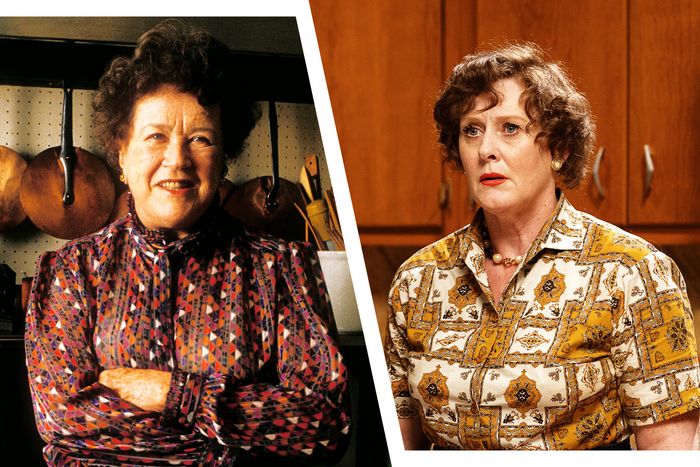
Before the release of the Meryl Streep–starring film Julie & Julia in 2009, Sarah Lancashire had never heard of Julia Child. “She had no public persona in the U.K. and wasn’t part of my childhood,” said Lancashire, a star of the British stage and of television series such as the crime drama Happy Valley, who is now making her debut to U.S. audiences as one of the most famous American chefs of all time. “It was the marketing for the film that was the first time I was aware of her.”
Lancashire still knew little beyond the basics of Child’s life when she got the script for Julia, an HBO Max series that picks up after her travels to France and the publication of her book Mastering the Art of French Cooking, when she premiered her pioneering cooking program The French Chef on Boston public television. Though Child didn’t loom large in Lancashire’s childhood, her ebullient presence is intimately familiar to American audiences whom she taught to roast a chicken and flip the contents of a frying pan. For Julia, Lancashire had to adopt Child’s specific patrician American accent and famously exuberant mannerisms while finding some understanding of what this very public figure was like in private. Vulture spoke with Lancashire and her collaborators about crafting a performance that doesn’t try to directly imitate Child as much as evoke her essence.
Writing Julia
The premise for the series originated at a lunch between Kimberly Carver, an executive producer on the series, and Todd Schulkin, executive director of the Julia Child Foundation for Gastronomy and the Culinary Arts. Both had worked in Hollywood, but things started out with a discussion of Child herself. “We were having a conversation about her love of Julia, and she was like, ‘We should do a show about her,’” Schulkin said. They discussed what could be explored after the period in France that Nora Ephron covered in Julia & Julia, landing on the idea of making a series about Child’s TV show The French Chef, which ran from 1963 to 1973. “Those were pivotal times in American history and also a time when Americans spent collectively more time in front of the television,” Schulkin said. Specifically, they wanted to explore how the cultural shift impacted Child’s marriage to retired diplomat Paul Child, played on the series by Frasier’s David Hyde Pierce. “What was her personal relationship like at the time where the whole world transformed and she went from Mrs. Paul Child to a national celebrity?”
From there, Carver asked Daniel Goldfarb, who was working on The Marvelous Mrs. Maisel, to write a pilot based on their premise. “I had written a pilot called Genesis about a mature marriage, and she had responded to it,” Goldfarb said. He leaped at the proposal. “I’ve always wanted to do a food-related show, and if you are a foodie, there is no better mountain to climb than Julia Child.”
Goldfarb then called Chris Keyser, a writer he’d worked with on the TV series Tyrant, and the two spun out more ideas for the series. One way of thinking about the structure of the first season, Keyser proposed, was shifting the Childs’ relationship from a traditional mid-century TV marriage to an equal partnership in which Julia’s rising fame means they have to negotiate. In the first episode, Julia hides from Paul the fact that she pitched her show to Boston public-TV network WGBH, claiming they asked her to do it, something Child did in real life. “That she would do that behind his back is very Lucy and Ricky Ricardo,” Keyser says. “We begin the season with an homage to stories about marriage on ’50s television. By the time the season is over, there aren’t secrets between them. We’ve moved away from old-fashioned sexual politics to something more complicated.”
Casting Julia
The show needed an actor who could embody someone as familiar as Julia Child. According to Charles McDougall, who directed Julia’s pilot, the suggestion to cast Lancashire came from Sarah Aubrey, HBO Max’s head of content. “She was a left-field suggestion to most people, but I knew how brilliant a dramatic actor she was,” McDougall said. He’d seen Lancashire onstage in a West End musical called Betty Blue Eyes, “so I knew she could handle comedy,” but he acknowledged that “it’s still a jump in mind-set” for those who know her from the intense Happy Valley.
Lancashire did a series of screen tests with wigs and makeup in early 2020. (“I thought she was going to walk away after being asked to do it so many times. She’s an actor who shouldn’t be tested anymore,” McDougall said.) After months of stalled production due to the COVID-19 lockdown, the group reassembled in the fall to film the pilot. “Sarah came back with this joie de vivre that absolutely gets Child. It doesn’t matter that she’s not physically the same. On the monitor, she was absolutely Julia,” McDougall said. “There was one moment on the pilot shoot where we were filming in the Union Oyster House in Boston. It was the glee she had eating these lobsters we fed her all day. Twenty-eight lobsters later, she was cracking them over with gusto.”
Looking like Julia
Those early screen tests needed to confirm that Lancashire, who bears some resemblance to Child but doesn’t have as round a face or her six-foot-two figure, could pass for the character she would be playing. The height was easy enough to fake; McDougall pointed out that they could tailor her clothes to make her torso appear longer and have Lancashire stand on ramps or other objects to elevate her position relative to the other actors.
To alter her face, they decided not to go as far as using prosthetics, which might have steered the show too close to imitation. Instead, they came up with a makeup routine that would alter her image to be close enough to Child’s. “The initial design was going to be simple makeup, reflective of the fact that Julia didn’t wear a lot of it herself,” makeup-department head Joe Rossi said. “Then Sarah had some strong ideas about how she should look that allowed us to use a little more highlighting and shading,” like applying more blush to the front of her face to round it out. A system that didn’t involve prosthetics could be done quickly. “We got the process down to wig and makeup under 45 minutes to an hour, which was great because she worked almost every day and was in almost every scene on the show.”
Crucial to the look was the wig. Hair-department head Jerry DeCarlo also worked on the hair in Julie & Julia (though not Streep’s as she had her own wig designer) and was familiar with the chef’s style. He came up with a design for Julia that would imitate Child’s naturally curly hair with the sides puffed out a bit and the top not quite as high as Child’s actual hair in order to make Lancashire’s own head seem wider. (The wig itself was made in England by Peter Owen and flown into America “on its own first-class seat,” McDougall joked.) “The hair is bits and pieces of several Julia Child hairstyles,” DeCarlo said. “The bangs were more prominent later in the ’60s, because that’s more how people remember her, but I kept the flat crown from the ’50s that makes it obvious she was doing her own hair.”
Capturing Julia
With a basic look in place, Lancashire focused on the specifics of the performance. In her movements, she tried to capture Child’s broad yet quite confident approach to physical comedy. As funny as some of Julia’s bits could be, especially when she was making fun of herself for messing up, Lancashire was careful not to be too silly. “She knew what she was doing in front the camera,” she said. “I look at her and see an eccentricity and wonderful unself-consciousness but an absolute truth in what she’s doing. She knew how to play to her audience very well.”
Most difficult was Child’s distinctively singsong way of speaking, which was based in her Waspy Pasadena upbringing but sounded entirely its own. “Her voice is extraordinarily difficult to mimic,” Lancashire said. She started working with a coach to master Child’s accent but decided she wouldn’t be able to master it through such a technical approach. “Julia has this very complex vocal range,” Lancashire explained. Child spoke in a specific accent but also used a broad speaking register, going high like a flute and low like a bassoon in quick succession. “I was left with no alternative than to find a parallel that was suggestive of her voice and had all the eccentricities and musicality of her,” Lancashire said. “That was a case of playing about until I found something I was comfortable with. She speaks like a musical score, and you can have a lot of fun with the unpredictability of the notes within her voice.”
Cooking like Julia
If you’re going to play Julia Child, you have to know how to cook, and you have to be able to cook well enough to capture her skillful — if often quite chaotic — approach to moving around the kitchen. Lancashire was taught to cook from a young age by her mother, who “probably should have been a professional and passed all that onto me and my siblings,” she explained. “And I’ve raised a family for several decades, so cooking has been part of my household chores. There was no fear about that.” But it was crucial that Child’s particular technique and her favorite dishes looked just right onscreen, which meant production had to cook the food the way Child did. “Everything we made on set was made to Julia’s recipe. I mean everything,” Lancashire said.
For that, Christine Tobin, the show’s food stylist, worked from a kitchen on the soundstages where they filmed, right next to the sets for the Childs’ home and the WGBH filming studio. “The kitchen lent a beating heart to the whole set, so the food traveled through the sets to the people who were re-creating the cooking on the sets,” Tobin said. “It piqued everyone’s curiosity when it came to dishes like the sweetbreads to come into the kitchen and try them for the first time.”
Tobin cooked and advised the actors on cooking Child’s recipes almost exactly as described in her cookbooks. She would consult with Lancashire about small technical questions and help choreograph a “dance” through the kitchen of how Julia would assemble her ingredients. Then, in her own kitchen, Tobin would cook as Julia would. “Her roast chicken is time-consuming because you have to babysit it, and that’s what we did,” Tobin said. For an episode in which they had to prepare raspberry mousse, she went through 750 eggs. “Just for the camera, I added a bit of a food gel to enhance the color of it because we were using fresh berries, and that doesn’t have the same visual effect from far away,” Tobin said. “But that was as far as I would go.”
Finding the private Julia
For Lancashire, the most important part of her process focused on what could be played quietly as a character known for being quite loud. “There’s a very public Julia and a very private Julia,” Lancashire said, and the private was often harder to find. She, the writers, and the directors did a lot of research into biographies of Child and her correspondence — Lancashire found her letters to her friend Avis DeVoto, played by Bebe Neuwirth, very useful, especially in the ways she “moans about Paul and gets flustered about certain things” — and spoke to people who knew her in order to understand what might’ve been going on behind Child’s own performance of the character of Julia Child.
“There was a story from a hotel manager who had taken her home from a foodie function at a hotel,” Lancashire said. “He was in his early 20s and put her in the car to drive her home, and she let out a huge sigh of relief and then sat in silence all the way home like the performance was over. Those silences speak volumes.” In Julia, there are similar moments between Julia and Paul, when the two let down their guards and, for instance, arrange paintings in his studio without speaking to each other. “Those are the moments that, I hope, really did exist in their lives,” Lancashire said. “I want this real marriage to have those beautiful, quiet moments, where you’re so at home with someone that you can live in those silences together.”





